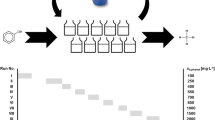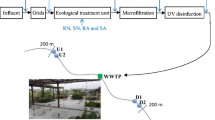Abstract
Biodegradation of phenolic compounds in bioreactors is well documented, but the changes in the bacterial populations dynamics during degradation were not that often. A glass bubble column used as reactor was inoculated with activated sludge, spiked with 2-chlorophenol, phenol and m-cresol after 28 days and maintained for an additional 56 days, while the 16S rRNA gene from metagenomic DNA was monitored. Proteobacteria (68.1%) dominated the inoculum, but the bacterial composition changed rapidly. The relative abundance of Bacteroidetes and Firmicutes decreased from 4.8 and 9.4 to <0.1 and 0.2% respectively, while that of Actinobacteria and TM7 increased from 4.8 and 2.0 to 19.2 and 16.1% respectively. Phenol application increased the relative abundance of Proteobacteria to 94.2% (mostly Brevundimonas 17.6%), while that of Bacteroidetes remained low (1.2%) until day 42. It then increased to 47.3% (mostly Leadbetterella 46.9%) at day 84. It was found that addition of phenolic compounds did not affect the relative abundance of the Alphaproteobacteria initially, but it decreased slowly while that of the Bacteroidetes increased towards the end.




Similar content being viewed by others
References
Abt B, Teshima H, Lucas S, Lapidus A, Del Río TG, Nolan M, Tice H, Cheng JF, Pitluck S, Liolios K, Pagani I, Ivanova N, Mavromatis K, Pati A, Tapia R, Han C, Goodwin L, Chen A, Palaniappan K, Land M, Hauser L, Chang YJ, Jeffries CD, Rohde M, Göker M, Tindall BJ, Detter JC, Woyke T, Bristow J, Eisen JA, Markowitz V, Hugenholtz P, Klenk HP, Kyrpides NC (2011) Complete genome sequence of Leadbetterella byssophila type strain (4M15T). Stand Genomic Sci 4:2–12
APHA (1999) Method 5220, standard methods for the examination of water and wastewater. American Public Health Association/American Water Works Association/Water Environment Federation, Washington DC
APHA (2005) Method 5530, standard methods for the examination of water and wastewater. American Public Health Association/American Water Works Association/Water Environment Federation, Washington DC
Baek SH, Kim KH, Yin CR, Jeon CO, Im WT, Kim KK, Lee ST (2003) Isolation and characterization of bacteria capable of degrading phenol and reducing nitrate under low-oxygen conditions. Curr Microbiol 47:462–466
Bai X, Shi H, Ye Z, Sun Q, Wang Q, Wang Z (2013) Degradation of bisphenol A by microorganisms immobilized on polyvinyl alcohol microspheres. Front Env Sci Eng 7:844–850
Bajaj M, Gallert C, Winter J (2008) Anaerobic biodegradation of high strength 2-chlorophenol-containing synthetic wastewater in a fixed bed reactor. Chemosphere 73:705–710
Banerjee A, Ghoshal AK (2010) Phenol degradation by Bacillus cereus: pathway and kinetic modelling. Bioresour Technol 101:5501–5507
Batut J, Anderson SG, O’Callaghan D (2004) The evolution of chronic infection strategies in the Alphaproteobacteria. Nat Rev Microbiol 2:933–945
Bertin L, Colao MC, Ruzzi M, Marchetti L, Fava F (2006) Performances and microbial features of an aerobic packed-bed biofilm reactor developed to post-treat an olive mill effluent from an anaerobic GAC reactor. Microb Cell Factories 5:2–11
Bhuiyan MNI, Takai R, Mitsuhashi S, Shigetomi K, Tanaka Y, Kamagata Y, Ubukata M (2016) Zincmethylphyrins and coproporphyrins, novel growth factors released by Sphingopyxis sp., enable laboratory cultivation of previously uncultured Leucobacter sp. through interspecies mutualism. J Antibioti 69:97–103
Cápiro NL, Da Silva MLB, Stafford BP, Rixey WG, Alvarez PJJ (2008) Microbial community response to a release of neat ethanol onto residual hydrocarbons in a pilot-scale aquifer tank. Environ Microbiol 10:2236–2244
Caporaso JG, Kuczynski J, Stombaugh J, Bittinger K, Bushman FD, Costello EK, Fierer N, Peña AG, Goodrich JK, Gordon JI, Huttley GA, Kelley ST, Knights D, Koenig JE, Ley RE, Lozupone CA, McDonald D, Muegge BD, Pirrung M, Reeder J, Sevinsky JR, Turnbaugh PJ, Walters WA, Widmann J, Yatsunenko T, Zaneveld J, Knight R (2010) QIIME allows analysis of high-throughput community sequencing data. Nat Methods 7:335–336
Duarte-Pereira A, Dutra-Leal C, França-Dias M, Etchebehere C, Augusto C, Chernicharo L, Calabria de Araújo J (2014) Effect of phenol on the nitrogen removal performance and microbial community structure and composition of an anammox reactor. Bioresour Technol 166:103–111
Edgar RC (2010) Search and clustering orders of magnitude faster than BLAST. Bioinformatics 26:2460–2461
Ei-Naas MH, Al-Muhtaseb SA, Makhlouf S (2009) Biodegradation of phenol by Pseudomonas putida immobilized in polyvinyl alcohol (PVA) gel. J Hazard Mater 164:720–725
François T, Hehemann JH, Czjzek M, Michel G (2011) Environmental and gut Bacteroidetes: the food connection. Front Microbiol 30:1–16
Ghasimi DS, Tao Y, de Kreuk M, Zandvoort MH, van Lier JB (2015) Microbial population dynamics during long-term sludge adaptation of thermophilic and mesophilic sequencing batch digesters treating sewage fine sieved fraction at varying organic loading rates. Biotechnol Biofuels 8:71
Hamady M, Lozupone C, Knight R (2010) Fast UniFrac: facilitating high-throughput phylogenetic analyses of microbial communities including analysis of pyrosequencing and PhyloChip data. ISME J 4:17–27
He X, McLean J, Edlund A, Yooseph S, Hall AP, Liu SY, Dorrestein PC, Esquenazi E, Hunter RC, Cheng G, Nelson KE, Lux R, Shi W (2014) Cultivation of a human-associated TM7 phylotype reveals a reduced genome and epibiotic parasitic lifestyle. Proc Natl Acad Sci U S A 112:244–249
Hu M, Wang X, Wen X, Xia Y (2012) Microbial community structures in different wastewater treatment plants as revealed by 454-pyrosequencing analysis. Bioresour Technol 117:72–79
Jemaat Z, Suárez-Ojeda ME, Pérez J, Carrera J (2014) Sequentially alternating pollutant scenarios of phenolic compounds in a continuous aerobic granular sludge reactor performing simultaneous partial nitritation and o-cresol biodegradation. Bioresour Technol 161:354–361
Joung Y, Kim H, Kang H, Lee BI, Ahn TS, Joh K (2014) Lacihabitans soyangensis gen. nov., sp. nov., a new member of the family Cytophagaceae, isolated from a freshwater reservoir. Int J Syst Evol Micr 64:3188–3194
Ju F, Zhang T (2014) Novel microbial populations in ambient and mesophilic biogas-producing and phenol-degrading consortia unravelled by high-throughput sequencing. Microb Ecol 68:235–246
Kaevska M, Videnska P, Vasickova P (2015) Changes in microbial composition of wastewater during treatment in a full-scale plant. Curr Microbiol 72:128–132
Khan MZ, Mondal PK, Sabir S (2011) Bioremediation of 2-chlorophenol containing wastewater by aerobic granules-kinetics and toxicity. J Hazard Mater 190:222–228
Kimura Z I, Hirano Y, Matsuzawa Y, Hiraishi A (2016) Effects of 3,5-dichlorophenol on excess biomass reduction and bacterial community dynamics in activated sludge as revealed by a polyphasic approach. J Biosci Bioeng In Press
Lapidus A, Nolan M, Lucas S, Del Rio TG, Tice H, Jan-Fang Cheng J-F, Tapia R, Han C, Goodwin L, Pitluck S, Liolios K, Pagani I, Ivanova N, Huntemann M, Mavromatis K, Mikhailova N, Pati A, Chen A, Palaniappan K, Land M, Evelyne-Marie Brambilla E-M, Rohde M, Abt B, Verbarg S, Göker M, Bristow J, Eisen JA, Markowitz V, Hugenholtz P, Kyrpides NC, Klenk HP, Woyke T (2011) Genome sequence of the filamentous, gliding Thiothrix nivea neotype strain (JP2T). Stand Genomic Sci 5:398–406
Lee DJ, Ho KL, Chen YY (2011) Degradation of cresols by phenol-acclimated aerobic granules. Appl Microbiol Biotechnol 89:209–215
Liu GH, Ye Z, Li H, Che R, Cui L (2012) Biological treatment of hexanitrostilbene (HNS) produced wastewater using an anaerobic–aerobic immobilized microbial system. Chem Eng J 213:118–124
Mahjoubi M, Jaouani A, Guesmi A, Amor SB, Jouini A, Cherif H, Cherif A (2013) Hydrocarbonoclastic bacteria isolated from petroleum contaminated sites in Tunisia: isolation, identification and characterization of the biotechnological potential. New Biotechnol 30:723–733
Mara D, Horan N (2003) Handbook of water and wastewater microbiology. Academic, London
Navarro-Noya YE, Suarez-Arriaga MC, Rojas-Valdes A, Montoya-Ciriaco N, Gómez-Acata S, Fernandez-Luqueño F, Dendooven L (2013) Pyrosequencing analysis of the bacterial community in drinking water wells. Microb Ecol 66:19–29
Nielsen PH, De Muro MA, Nielsen JL (2000) Studies on the in situ physiology of Thiothrix spp. present in activated sludge. Environ Microbiol 2:389–398
Percudani R (2013) A microbial metagenome (Leucobacter sp.) in caenorhabditis whole genome sequences. Bioinform Biol Insights 24:55–72
Pérez-González D, Gómez J, Beristain-Cardoso R (2012) Biological removal of p-cresol, phenol, p-hydroxybenzoate and ammonium using a nitrifying continuous-flow reactor. Bioresour Technol 120:194–198
Price MN, Dehal PS, Arkin AP (2009) FastTree: computing large minimum evolution trees with profiles instead of a distance matrix. Mol Biol Evol 26:1641–1650
Rahman NHA, Rahman NAA, Aziz SA, Hassan MA (2013) Production of ligninolytic enzymes by newly isolated bacteria from palm oil plantation soils. Bioresources 8:6136–6150
Saimmai A, Tani A, Sobhon V, Maneerat S (2012) Mangrove sediment, a new source of potential biosurfactant-producing bacteria. Ann Microbiol 62:1669–1679
SAS Institute Inc. (1989) Statistic guide for personal computers, version 6.04. SAS Institute, Cary
Silva CC, Hayden H, Sawbridge T, Mele P, De Paula SO, Silva LCF, Vidigal PMP, Vicentini R, Sousa MP, Torres APR, Santiago VMJ, Oliveira VM (2013) Identification of genes and pathways related to phenol degradation in metagenomic libraries from petroleum refinery wastewater. PLoS One 8:e61811
Silva CD, Beristain-Montiel L, Cuervo-López FM, Texier AC (2014) p-Cresol mineralization and bacterial population dynamics in a nitrifying sequential batch reactor. J Environ Sci 26:1885–1893
Tumaikina YA, Turkovskaya OV, Ignatov VV (2008) Degradation of hydrocarbons and their derivatives by a microbial association on the base of Canadian pondweed. Appl Biochem Microbiol 44:382–388
USEPA (2014) Hazardous waste test methods. SW-846. http://www.epa.gov/hw-sw846
Wei G, Yu J, Zhu Y, Chen W, Wang L (2008) Characterization of phenol degradation by Rhizobium sp. CCNWTB 701 isolated from Astragalus chrysopteru in mining tailing region. J Haz Mat 151:111–117
Winsley TJ, Snape I, McKinlay J, Stark J, van Dorst JM, Ji M, Ferrari BC, Siciliano SD (2014) The ecological control on the prevalence of candidate division TM7 in polar regions. Front Microbiol 15:1–10
Yun JH, Cho YJ, Chun J, Hyun DW, Bae JW (2014) Genome sequence of the chromate-resistant bacterium Leucobacter salsicius type strain M1-8T. Stand Genomic Sci 9:495–504
Acknowledgments
The research was funded by Cinvestav. S. G.-A., I. E.-R. and A. R.-V. received grant-aided support from “Consejo Nacional de Ciencia y Tecnología” (CONACyT) and Y. N.-N. from ABACUS-CONACyT (Mexico).
Author information
Authors and Affiliations
Corresponding author
Ethics declarations
No human or animal subjects were used in this study.
Conflict of interest
The authors declare that they have no conflict of interest.
Informed consent
Informed consent was obtained from all individual participants included in the study.
Additional information
Selene Gómez-Acata and Ivonne Esquivel-Ríos contributed equally to the manuscript.
Electronic supplementary material
ESM 1
(PDF 188 kb)
Rights and permissions
About this article
Cite this article
Gómez-Acata, S., Esquivel-Ríos, I., Pérez-Sandoval, M.V. et al. Bacterial community structure within an activated sludge reactor added with phenolic compounds. Appl Microbiol Biotechnol 101, 3405–3414 (2017). https://doi.org/10.1007/s00253-016-8000-z
Received:
Revised:
Accepted:
Published:
Issue Date:
DOI: https://doi.org/10.1007/s00253-016-8000-z




